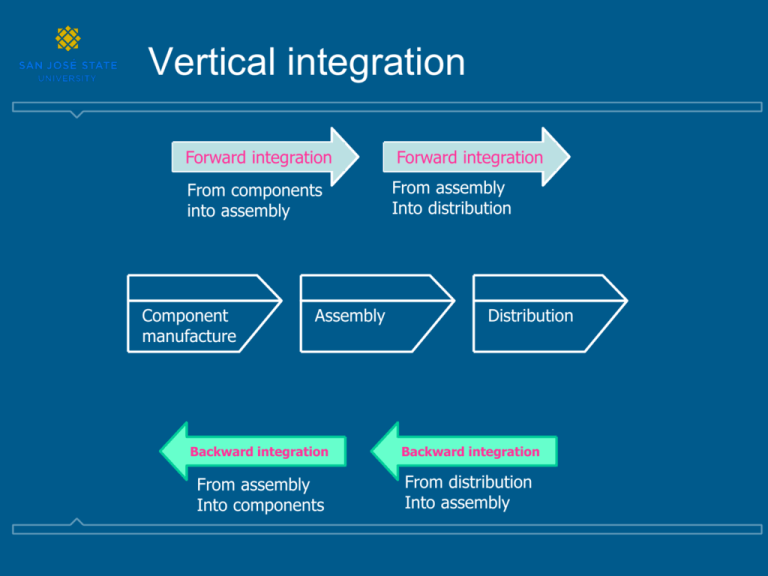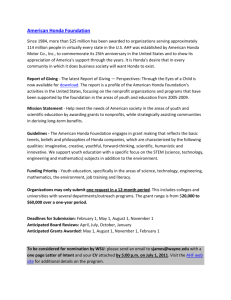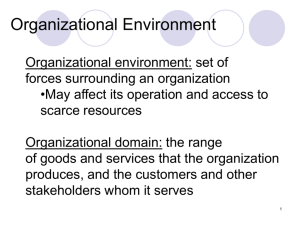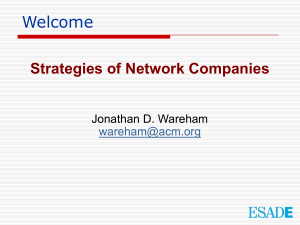Vertical Integration and Transaction Cost Economics (TCE)
advertisement

Vertical integration Forward integration Forward integration From components into assembly From assembly Into distribution Component manufacture Assembly Distribution Backward integration Backward integration From assembly Into components From distribution Into assembly Vertical Integration ► Facilitate investment in specialized assets up- or down-stream in the value chain • Protect product quality ► General Foods bananas ► Singer sewing-machines • Improve scheduling ► ► Looks like JIT… Create barriers to entry/imitation • Prevent competitors accessing quality supplies ► Alcoa and its bauxite mine ► General foods bananas Diminishing Marginal Cost ► Each additional item of a kind acquired is costs less to produce than the preceding one ► Earlier items are more costly than later ones cost of first item cost of second item 1 2 3 4 Diminishing Marginal Value ► Each additional item of a kind acquired is valued less than the preceding one just acquired ► Earlier items are valued more than later ones value of second item value of first item 1 2 3 4 (Economic) Exchange Exchange in general B A Barter A Goods or service B Exchange Economic Exchange Goods or services Money based transactions Monetary transaction A Goods or services Money B Transaction Cost Economics ► Started with an odd question posed by Ronald Coase in 1932: “Why do firms exist”? ► Developed by Oliver Williamson starting 1977, becoming a new branch of economics. ► Both have been awarded Nobel prizes ► Answers the question: “when should firms make inputs they need (in-house) or buy them from another firm (outsource)”? Firms and markets ► Firms and markets are alternative institutional arrangements for facilitating exchange ► Employment contracts are generally less specific than market contracts ► Exchange under each institutional arrangement incurs transaction costs ► In some circumstances, firms incur lower transaction cost than would be the case in the market The Market for Lemons ► George Akerlof’s problem • Lemons (often cars built on Friday afternoons or Monday mornings) are less reliable than cars built mid week. • Suppose that on the second hand market, a year-old lemon is worth $8,000 and a good year-old car is worth $10,500 • Suppose there four times as many good cars as lemons • Although the seller knows whether he has a lemon or not, the buyer doesn’t so, the buyer must estimate the likely value of a car: ► E(v) = .2 * $10,500 + .8 * $8,000 = $10,000 • If the rational buyer offers only $10,000 then sellers of nonlemons will not bother to advertise since they will never be paid what their cars are worth, and only sellers of lemons will remain. Market exchange Low asset specificity/uncertainty A Goods B Money High asset specificity/uncertainty for A A Goods B Money ++ Cost of writing contract Provision for ‘default’ With high asset specificity/uncertainty Carried out in the open market A Good or Service B Money Cost of writing contract Provision for ‘default’ Carried out in a single firm A Good or Service Money B Transaction costs c default * pr default No safeguards Market c contract cost Contractual or other safeguards Firm c bureaucratic costs Drivers of Transaction Costs ► Asset specificity • Is your investment tied to this one transaction (or contract)? ► Uncertainty • Behavioral • • Reliability - how much can you trust this firm? Information asymmetry • Technological • how likely is it that you are backing the wrong horse? • Volume • how reliable are market growth predictions? Firm or Market? Cost Optimal exchange in the market Optimal exchange Inside the firm Asset specificity and uncertainty Market transaction costs Internal bureaucratic costs The Hold-up Problem Hold-up problem ► Ex ante • Mine asks railroad for a quote • railroad calculates based on capital and operating costs • Deal is struck • mine and rail road are built ► Ex post • Mine claims ‘financial distress’, • offers just over marginal cost • Railroad has to take the lower price ► Result • anticipating this, railroad will never agree to the deal ► One solution • mine builds and operates the rail link Honda (UK) - the initial idea ► British Layland (BL) needs new models • MD Mike Edwardes establishes a joint venture with Honda • The Honda Accord will be sold by Honda and BL (badged as the Triumph Acclaim) • UK suppliers will get additional work and the Midlands will be reinvigorated Honda (UK) - the outcome ► Honda has very exacting quality standards (while BL does not) ► BL’s gearbox suppliers would need to retool to meet Honda’s quality requirements. ► This investment is firm specific and uncertain ► Market failure results and Honda is forced to source gearboxes from Japan. Examples ► Backward VI • Assuring input quality (General Foods) • Assuring delivery reliability (Ford, early JIT) • Honda (UK, 197?) ► Forward VI • Assuring adequate marketing/customer training (Singer, Kodak) Drawbacks of vertical integration ► Assumption of risk • Technological change • Demand fluctuation • BUT uncertainty is in part why VI happens to there is no real alternative ► Lack of market discipline • Transfer prices are a matter of internal negotiation • BUT if there is no market, there is no price Alternatives ► Long term contracts • (NO - for reasons we have just seen) ► Incentive Alignment • Equity joint venture (but this is really a firm) ► Economic ‘trust’ • Repeated game with the same player • Reputation - repeated game with the other players • ‘Exchange of hostages’ - mutual dependence ► Real trust • Toyota Outsourcing ► Activities that are not distinctive? • “Stick to the knitting”; outsource everything else • Benefit from suppliers’ economies of scale • Derive benefits from specialization, flexibility, market efficiency and discipline ► BUT • Beware of creating powerful suppliers Summary ► Vertical Integration is useful to: • Facilitate investment in specialized assets up- or down-steam in the value chain ► Protect product quality ► Improve scheduling • Create barriers to entry/imitation ► Prevent competitors accessing quality supplies or markets





